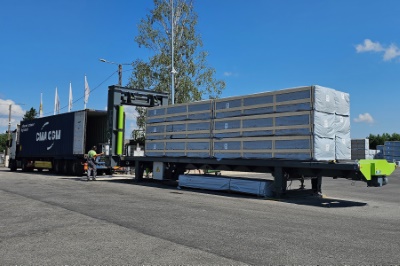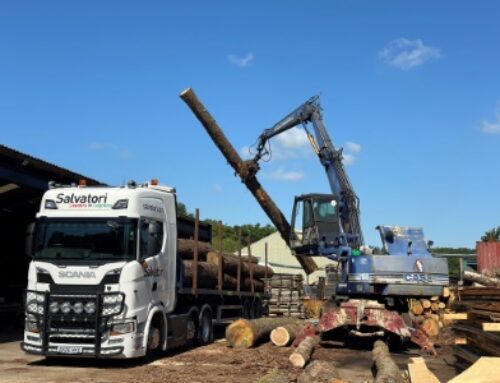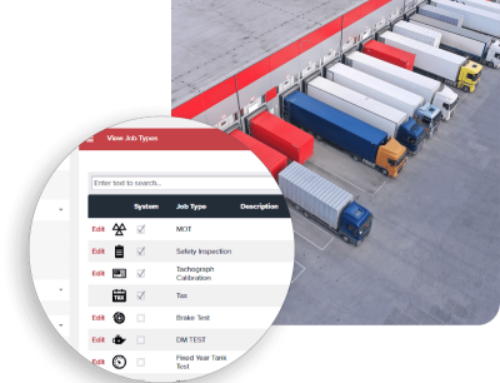How automated loading is transforming road freight efficiency
Martins Nikis, CEO of SmartTEH, discusses the operational advantages of automated loading systems
 HGV operators face growing pressures of tight delivery windows, rising fuel and labour costs, and driver shortages. Even when trucks are ready to roll, time spent at the loading bay eats into profitability.
HGV operators face growing pressures of tight delivery windows, rising fuel and labour costs, and driver shortages. Even when trucks are ready to roll, time spent at the loading bay eats into profitability.
Despite major advances in fleet management, route optimisation, and vehicle tech, loading and unloading remain some of the least automated stages of road transport.
Automated loading systems are closing that gap. They improve logistics operations by speeding up the loading process, reducing the need for manual labour, and making cargo handling much safer.
Manual loading is slow, labour-intensive, and inconsistent – especially when handling heavy or palletised goods. Every extra minute spent at the dock is a minute lost on the road.
Common challenges include long turnaround times and idling vehicles. A 45-foot trailer can take up to an hour to load manually – and that’s before factoring in queue times at busy docks. Multiply that by multiple trucks per day, and it quickly adds up to dozens of wasted driver hours every week.
Inefficient space utilisation is another concern. Manual loading often leads to uneven cargo distribution and wasted cubic capacity. Even a five per cent loss in space efficiency means more trips to move the same volume.
A further consideration is safety and workforce strain. Repetitive lifting, forklift traffic, and tight schedules increase the risk of injury and downtime. These incidents also affect delivery reliability and insurance costs.
Labour dependency and scheduling issues are a factor. Manual loading requires coordination between drivers, warehouse teams, and shift patterns. Staff shortages can quickly disrupt operations.
Finally, performance can be unpredictable. Human error – from misaligned pallets to incorrect stacking – causes damage, claims, and rework. In an industry where margins are tight and delivery expectations are high, these inefficiencies aren’t minor inconveniences – they’re structural bottlenecks.
How automated loading works for HGV fleets
An automated loading system is a mechanised platform with a moving floor that transfers goods into trailers and containers in a matter of minutes. It makes it possible to preload goods before the truck arrives and load everything into the trailer in one shot.
It’s compatible with all standard trailers and 20-foot, 40-foot and 45-foot containers. For example, SmartTEH systems can be customised to match each operator’s cargo type, facility layout, and loading requirements – ensuring seamless integration into existing processes.
The loading system handles palletised and bulky goods, and it’s easy to integrate into existing workflows at warehouses, production facilities, and logistics centres.
Here’s how automation translates into measurable results for fleet operators.
Automated loading systems tackle inefficiencies, moving full loads faster, safer, and more consistently.
Benefits include faster turnaround times: automated systems can load and unload a full trailer in as little as 5–10 minutes, compared to 45–60 minutes manually. That means trucks spend less time idling and more time earning.
Even a 20-minute reduction per load adds up to hours of extra driving time per vehicle each day.
Improved safety and compliance is another advantage. Automation reduces manual lifting, forklift movements, and human intervention around heavy machinery. This helps companies meet stricter workplace safety standards while lowering the risk of accidents and lost-time injuries.
A safer loading bay also improves morale and retention among drivers and warehouse staff.
Automated loading can also help ensure consistent quality and cargo protection. Every load follows the same optimised process, meaning fewer damaged goods, more stable stacking, and better trailer fill ratios. Uniform, precise loading improves weight distribution and overall vehicle stability, contributing to safer road transport and lower maintenance costs over time.
Fleets may benefit from lower operational costs: reducing manual labour directly cuts overheads, but that’s only part of the savings story. Automated systems also minimise fuel waste from idling vehicles and reduce wear on forklifts and loading equipment.
Energy-efficient operation reduces downtime and drives measurable savings.
Most automated loading systems pay for themselves within 1-2 years through labour, time, and efficiency savings – but the long-term benefits extend far beyond that. Fleets gain predictability, scalability, and the ability to handle higher volumes without expanding headcount or facilities.
Looking ahead: automation as a competitive advantage
Road transport is constantly evolving – from real-time fleet tracking and electric vehicles to AI-driven route optimisation – and automation at the loading dock completes the efficiency loop.
Fleets that modernise their loading operations today gain a clear edge in productivity, safety, and sustainability. Automation can lead to lower emissions, faster turnaround, happier drivers, and stronger customer relationships.
For logistics providers competing on speed and reliability, automation is no longer a luxury – it’s a strategic upgrade.
The next era of road transport efficiency won’t just happen on the highway. It’ll start at the loading dock.












